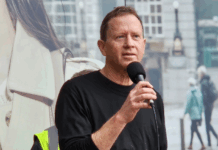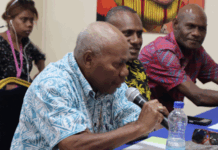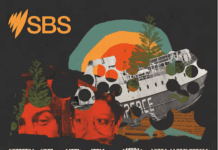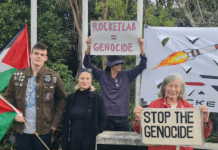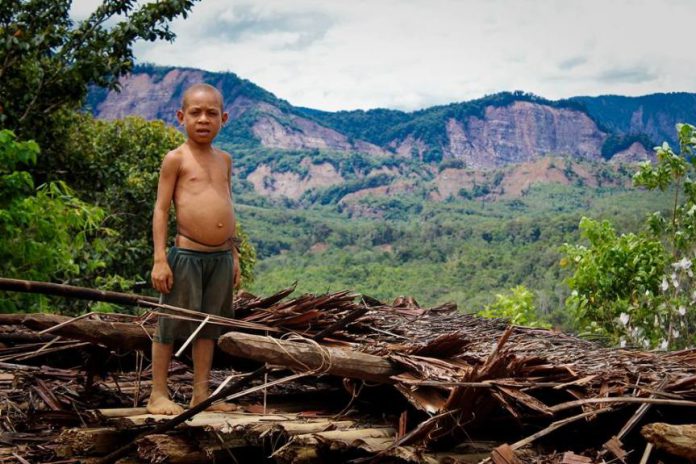
SPECIAL REPORT: Anton Lutz in Mougulu profiles what life is like on the border of Western Province and Hela at the epicentre three weeks after Papua New Guinea’s earthquakes.
This week a disaster relief team operating out of Mougulu in Western Province demonstrated how key partnerships can lead directly to efficient outcomes.
As the largest earthquake in more than 100 years rocked the centre of New Guinea in the early hours of February 26, I lay petrified in my bed, listening as things fell all through the house.
As the shock waves subsided, I flipped on my phone and checked in with my friends in Mt Hagen, Goroka, Lae. They were shaken, but ok. But we were the fortunate ones.
Days passed and every day we learned more of what had befallen the people nearer the epicentre. I knew I had to do something to help the people most affected. I contacted Mission Aviation Fellowship (MAF) and my longtime friend Sally Lloyd, a woman who not only grew up in Mougulu where her parents have served the Biami people for 50 years, but who has devoted much of her adult life to continuing that legacy and selflessly serving her people in that area.
“I want to help. Is there anything you think I can help with?” I asked. “Yes!” was the reply.

Preparing for the journey to Mougulu
By the time March 4 came around, I was in Hagen coming up to speed on the information that was coming in on the HF radio network and through the MAF pilots who were working in the affected areas southwest of the earthquake.
Following meetings with MAF and the PNG Defence Force (PNGDF) and their Australian Defence Force(ADF) counterparts on March 5, a plan was formed that Sally and I would go to Mougulu in Western Province and form part of a forward operating base to help MAF and MAF’s partners facilitate the disaster relief work.
I bought some tinfish and rice and charged up my phone.
That night, Sally told me the good news that Ok Tedi Mining Ltd (OTML) was working with the office of the MP for North Fly, James Donald, and that a helicopter and pilot would be ready to assist our work the next morning.
On March 6, we were picked up by a helicopter in Hagen and taken to Huya and Dodomona, two of the worst affected places on this side of Mt Sisa. Sally wanted to stay overnight with the people at Huya so that she could get a good sense of what was happening there.
I reckoned I could do a night with the refugees at Dodomona; after all, what’s the worst that could happen?
Earthquake strikes
Our assessment process involved meeting with the ward councillors and pastors, the village recorders and the local leaders. We did earthquake education, listened, prayed with them and asked about health problems, displaced persons, damages to houses and gardens, injured and missing persons, deaths.
By the time midnight struck, I was fast asleep, but only just.
Just in time to be lifted out of bed by a 6.7M earthquake detonating under Dodomona like a nuclear bomb.
By the time I got out of the house, part of it had fallen. The aid post which had stood for 38 years had fallen to the ground. People had minor injuries and were standing in the dark, afraid to go near the houses that they’d been sleeping in moments before.
A pile of mumu stones that I’d stood on to take a photo six hours earlier had vibrated so fiercely that the stones were now spread out all over the village. But we had it easy.
Over at Huya, Sally and the refugees huddled on the airstrip as the cliffs in the distance gave way, weakened a week earlier by the 7.5M, and huge landslides now fell, one after the other, for hours. The noise of a rushing howling wind thundered down on them.
People cried out in fear. The slopes below the airstrip fell away into the river. Cracks opened in the airstrip as the shock waves went on and on.
At dawn we surveyed the damage. We cared for those we could and arranged for medevacs for those who needed more than first aid.
Later that day we met up in Mougulu with team volunteer Samson Suale, MP James Donald, North Fly Project Officer Larry Franklin and officers from the Western Province Disaster Office and the North Fly District Disaster Office.
As a matter of high priority, even before coffee, I related my findings from Dodomona to the group. People were missing and presumed dead. Others were believed to be trapped and dying on the other side of a treacherous, mud-choked river.
We looked at each other. “Let’s go!” several of us said at once.

The clean-up begins
That was nearly three weeks ago. Every day since has been that intense, that focused, that full-on.
We found the “dead” people. They weren’t dead. We found the missing people. We conducted our community assessments in 26 locations from Tinahae in the north to Fogomaiyu in the south, carefully identifying and communicating which locations which will need ongoing aid and which will not.
We learned which people were displaced, where they were moving, and what they were fleeing.
We moved patients who needed help to the health center at Mougulu. Nearly 20 of them. We rescued a woman with cerebral palsy who had been abandoned by her community as they fled. She was alone for nearly four days before I came in the helicopter to take her back to where her community had fled.
We’ve dismantled the fallen aid post at Dodomona and rebuilt it in three days. Take what is fallen, make something useful out of it, get on with life.
Two newly graduated community health workers volunteered to treat patients there with medicines that we got out of Hagen. They’re there now, treating yaws, grille, diarrhea and so many sores.
We’ve installed water tanks at Dodomona, Adumari and Huya. We’ve helped the Rural Airstrip Agency conduct a two-day technical assessment of the fractures in the airstrip at Huya which will allow a plan to be put in place for its repair and re-opening.
We’ve given people the tools they’ll need to rebuild houses, gardens, lives. Hundreds of tools, thousands of packets of nails.

And, of course, we’ve delivered aid. Food aid. Water. Tarpaulins, tents, pots and blankets. Family hygiene kits. All donated by individuals, churches, business houses, CARE International, the North Fly MP’s Office, OTML. All of it flown by Adventist Aviation Services, MAF, Summer Institute of Linguistics (SI), and the ADF Chinooks.
This natural disaster has highlighted what many of us have known all along, that there are people living on the outer edges of Papua New Guinea. People like you and me.
People, however, who do not have soap or salt, a school or an aid post. People whose lives have been shattered by the mountain collapsing beneath them and who must now survive long enough to rebuild.
For the people gathered now at Adumari, Dodomona, Huya and Walagu, perhaps their greatest need now is that their plight is not politicised nor impeded by infighting among the aid groups.
They have a long road ahead of them as they decide whether or not to permanently abandon their damaged homes and villages, and if so, how to build new lives that are full of meaning and possibility.
Our small team here at Mougulu has shown how cooperation and transparency can achieve significant outcomes and I, for one, am proud that I was part of that.
Anton Lutz is an American missionary living in Papua New Guinea. This article was first published on Scott Waide’s blog My Land, My Country and has been republished by Asia Pacific Report with permission.


